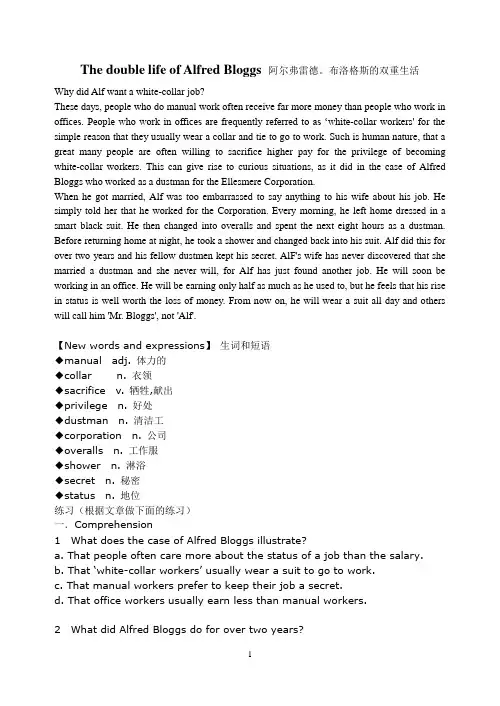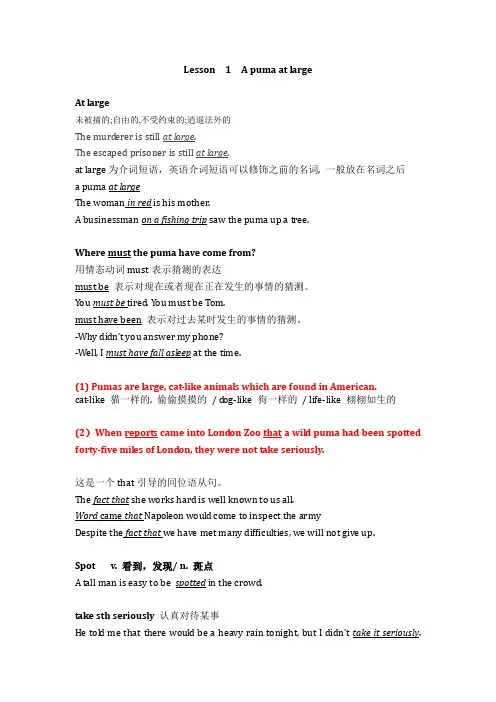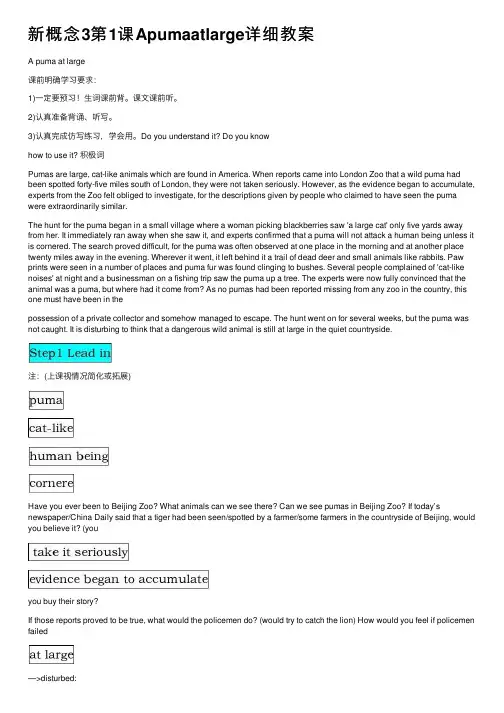经典:新概念英语三第一课教案
- 格式:ppt
- 大小:2.39 MB
- 文档页数:12

The double life of Alfred Bloggs 阿尔弗雷德。
布洛格斯的双重生活Why did Alf want a white-collar job?These days, people who do manual work often receive far more money than people who work in offices. People who work in offices are frequently referred to as ‘white-collar workers' for the simple reason that they usually wear a collar and tie to go to work. Such is human nature, that a great many people are often willing to sacrifice higher pay for the privilege of becoming white-collar workers. This can give rise to curious situations, as it did in the case of Alfred Bloggs who worked as a dustman for the Ellesmere Corporation.When he got married, Alf was too embarrassed to say anything to his wife about his job. He simply told her that he worked for the Corporation. Every morning, he left home dressed in a smart black suit. He then changed into overalls and spent the next eight hours as a dustman. Before returning home at night, he took a shower and changed back into his suit. Alf did this for over two years and his fellow dustmen kept his secret. AlF's wife has never discovered that she married a dustman and she never will, for Alf has just found another job. He will soon be working in an office. He will be earning only half as much as he used to, but he feels that his rise in status is well worth the loss of money. From now on, he will wear a suit all day and others will call him 'Mr. Bloggs', not 'Alf'.【New words and expressions】生词和短语◆manual adj. 体力的◆collar n. 衣领◆sacrifice v. 牺牲,献出◆privilege n. 好处◆dustman n. 清洁工◆corporation n. 公司◆overalls n. 工作服◆shower n. 淋浴◆secret n. 秘密◆status n. 地位练习(根据文章做下面的练习)一.Comprehension1 What does the case of Alfred Bloggs illustrate?a. That people often care more about the status of a job than the salary.b. That ‘w hite-collar workers’ usually wear a suit to go to work.c. That manual workers prefer to keep their job a secret.d. That office workers usually earn less than manual workers.2 What did Alfred Bloggs do for over two years?a. He told his wife he worked for the Corporation, when in fact he did not.b. He disguised himself as a dustman.c. He led a double life.d. He earned twice as much as he used to.3 Why did Alfred Bloggs consider wearing a suit all day and being called ‘Mr. Bloggs’ so important?a. His new job is worth more than his previous one in every respect.b. He will no longer need a shower before returning home from work.c. He can now tell his wife about his previous job without embarrassment.d. He feels that other people will respect him more.二.Structure4 They usually wear a collar and tie … (l.4)a. as they workb. to workc. going to workd. in order to work5 Alf was anything to his wife. (l.9)a. so embarrassed he saidb. very embarrassed and saidc. very embarrassed, so he saidd. so embarrassed he did not say6 He told her that he worked for the Corporation …(ll.9-10)a. simplyb. in a simple wayc. and no mored. only7 Before he home at night, he took a shower… (ll.11-12)a. was returningb. returnedc. had returnedd. will return8 His earnings were only half the amount …(l.14)a. as they used tob. they used toc. they used to bed. they were 三.Vocabulary9 Manual workers often receive much higher than people who work in offices.(ll.1-2)a. gainsb. feesc. paymentsd. wages10 His kept his secret. (l.12)a. brothers b workmates c. companions d. comrades11 His rise in status more than the loss of money. (l.14-15)a. pays backb. rewardsc. compensates ford. values12 he wanted to be ‘Mr. Bloggs’ , not ‘Alf.’ . (ll.15-16)a. addressed asb. namedc. cried outd. shouted。


新概念英语第三册教案L e s s o n1-2(共7页) -本页仅作为预览文档封面,使用时请删除本页-Lesson 01 A Puma at large 逃遁的美洲狮Part One: New words and expression 生词和短语1、puma n.美洲狮 a large cat-like animallion, tiger, leopard豹, jaguar美洲虎, cougar美洲豹, cheetah猎豹, lynx大山猫, panther黑豹2、spot v.看出, 发现to see or find sth with difficulty不易察觉= see, pick out, recognize, catch sight of强调结果, 辨别出, 看见, 识别, 发现同意词:-- find:强调发现的结果 / find out:查出事实真相-- discover:做出重大发现 / notice:注意到-- observe:观察 / watch:观察活动中的人或画面observe: to see and notice sth(正式) 观察,观测discover: to find sth already in existencerecognize: to figure out sth/sb known alreadydetect: to disclose sth hidden or in disguise 探测explore: to examine sth thoroughly in order to test of find about it Internet Explorer Spot 点,斑点 a beauty spot, solar spot, -- There is a white spot on the shirt. spotlight, be in the spotlight Tom Cruse is in the spotlight in American film industry.A leopard will not change its spot. 江山易改,本性难移on the spot有两个含义:1> 立刻, 马上(at once, immediately)--Anyone breaking the rules will be asked to leave on the spot.2> at the place of the action 在现场-- Wherever she is needed,she is quickly on the spot.3、Evidence n.证据(不可数名词)Evident adj.明显的, 显然的 / evidently adv.明显地, 显然Evidence = proof (n.证据)-- When the police arrived,he had already destroyed the evidence.in evidence 显而易见的-- He was in evidence at the party.witness 证人,judge法官,jury陪审团,court of law法庭self-evident a.不言自明的 The Declaration of Independence: We hold these truths to beself-evident, that all men are created equal, that they are endowed by their Creator with certain unalienable rights, that among these are life, liberty and the pursuit of happiness. 我们认为以下事实是不言自明的:所有的人都是生而平等的,他们天生就被上帝赋予了不可剥夺的权利,人有生存的权利,获得自由的权利,追求幸福的权利。


Lesson 01 A Puma at large 逃遁的美洲狮Part One: New words and expression 生词和短语1、puma n.美洲狮a large cat-like animallion, tiger, leopard豹, jaguar美洲虎, cougar美洲豹, cheetah猎豹, lynx大山猫, panther黑豹2、spot v.看出, 发现 to see or find sth with difficulty不易察觉= see, pick out, recognize, catch sight of强调结果, 辨别出, 看见, 识别, 发现同意词:-- find:强调发现的结果/ find out:查出事实真相-- discover:做出重大发现/ notice:注意到-- observe:观察/ watch:观察活动中的人或画面observe: to see and notice sth(正式) 观察,观测discover: to find sth already in existencerecognize: to figure out sth/sb known alreadydetect: to disclose sth hidden or in disguise 探测explore: to examine sth thoroughly in order to test of find about it Internet ExplorerSpot 点,斑点a beauty spot, solar spot, -- There is a white spot on the shirt.spotlight, be in the spotlight Tom Cruse is in the spotlight in American film industry.A leopard will not change its spot. 江山易改,本性难移on the spot有两个含义:1> 立刻, 马上(at once, immediately)-- Anyone breaking the rules will be asked to leave on the spot.2> at the place of the action 在现场-- Wherever she is needed, she is quickly on the spot.3、Evidence n.证据(不可数名词)Evident adj.明显的, 显然的/ evidently adv.明显地, 显然Evidence = proof (n.证据)-- When the police arrived, he had already destroyed the evidence.in evidence 显而易见的-- He was in evidence at the party.witness 证人,judge法官,jury陪审团,court of law法庭self-evident a.不言自明的The Declaration of Independence: We hold these truths to be self-evident, that all men are created equal, that they are endowed by their Creator with certain unalienable rights, that among these are life, liberty and the pursuit of happiness. 我们认为以下事实是不言自明的:所有的人都是生而平等的,他们天生就被上帝赋予了不可剥夺的权利,人有生存的权利,获得自由的权利,追求幸福的权利。




Lesson 1 A puma at largeAt large未被捕的;自由的,不受约束的;逍遥法外的The murd erer is still at large.The escaped prisoner is still at large.at large为介词短语,英语介词短语可以修饰之前的名词, 一般放在名词之后a puma at largeThe woman in red is his mother.A businessman on a fishing trip saw the puma up a tree.Where must the puma have come from?用情态动词must表示猜测的表达must be 表示对现在或者现在正在发生的事情的猜测。
You must be tired. You must be Tom.must have been 表示对过去某时发生的事情的猜测。
-Why didn’t you answer my phone?-Well, I must have fall asleep at the time.(1) Pumas are large, cat-like animals which are found in American.cat-like 猫一样的, 偷偷摸摸的/ d og-like 狗一样的/ life-like 栩栩如生的(2)When reports came into London Zoo that a wild puma had been spotted forty-five miles of London, they were not take seriously.这是一个that引导的同位语从句。
The fact that she works hard is well known to us all.Word came that Napol eon woul d come to inspect the armyDespite the fact that we have met many difficulties, we will not give up.Spot v. 看到,发现/ n. 斑点A tall man is easy to be spotted in the crowd.take sth seriously 认真对待某事He tol d me that there woul d be a heavy rain tonight, but I didn’t take it seriously.As a result, I was caught in the rain.Nearly everyone warned him of the danger, but he did’t taken it seriously.(3) However, as the evidence began to accumulate, experts from the Zoo felt obliged to investigate, for the descriptions given by people who claimed to have seen the puma were extraordinarily similar.However/as/forHowever 并列连词,表示句意上的转折as 引导时间状语从句,表示“随着----”for 引导原因状语从句,表示原因。

新概念3第1课Apumaatlarge详细教案A puma at large课前明确学习要求:1)⼀定要预习!⽣词课前背。
课⽂课前听。
2)认真准备背诵、听写。
3)认真完成仿写练习,学会⽤。
Do you understand it? Do you knowhow to use it? 积极词Pumas are large, cat-like animals which are found in America. When reports came into London Zoo that a wild puma had been spotted forty-five miles south of London, they were not taken seriously. However, as the evidence began to accumulate, experts from the Zoo felt obliged to investigate, for the descriptions given by people who claimed to have seen the puma were extraordinarily similar.The hunt for the puma began in a small village where a woman picking blackberries saw 'a large cat' only five yards away from her. It immediately ran away when she saw it, and experts confirmed that a puma will not attack a human being unless it is cornered. The search proved difficult, for the puma was often observed at one place in the morning and at another place twenty miles away in the evening. Wherever it went, it left behind it a trail of dead deer and small animals like rabbits. Paw prints were seen in a number of places and puma fur was found clinging to bushes. Several people complained of 'cat-like noises' at night and a businessman on a fishing trip saw the puma up a tree. The experts were now fully convinced that the animal was a puma, but where had it come from? As no pumas had been reported missing from any zoo in the country, this one must have been in thepossession of a private collector and somehow managed to escape. The hunt went on for several weeks, but the puma was not caught. It is disturbing to think that a dangerous wild animal is still at large in the quiet countryside.注:(上课视情况简化或拓展)Have you ever been to Beijing Zoo? What animals can we see there? Can we see pumas in Beijing Zoo? If today’s newspaper/China Daily said that a tiger had been seen/spotted by a farmer/some farmers in the countryside of Beijing, would you believe it? (youyou buy their story?If those reports proved to be true, what would the policemen do? (would try to catch the lion) How would you feel if policemen failed—>disturbed:注:教学步骤——了解英英释义;引⼊课⽂⽤法,不出课⽂原句;平⾏⼩练;不⽤⼤讲⽤法,放到language points部分讲of,collector, descriptions, take sth seriously, complain ofPumas are large, cat-like animals which are found in __________. When reports came into London Zoo that a wild puma had beenspotted forty-five miles _______of London, they were not taken seriously. However, as the evidence began to accumulate, experts from the Zoo felt obliged to investigate, for the descriptions given by people who claimed to ____________the puma were extraordinarily similar.The hunt _____ the puma began in a small village where a woman__________blackberries saw 'a large cat' only five yards away from her. It immediately ran away when she saw it, and experts confirmed that a puma will not attack a human being _________ it is cornered. The search proved ________, for the puma was often observed at one place in the morning and at _________place twenty miles away in the evening. Wherever it went, it _______behind it a trail of dead deer and small animals like rabbits. Paw prints were seen in a number of places and puma fur was _________clinging to bushes. Several people complained of 'cat-like noises' at night and a businessman on a fishing trip saw the puma up a tree. The experts were now fully convinced that the animal was a puma, but where had it come from? As no pumas had been reported _________ from any zoo in the country, this one must have been in the possession of a private collector and somehow ________ to escape. The hunt _________ for several weeks, but the puma was not _________. It is disturbing to think that a dangerous wild animal is still at large in the quiet countryside.1 What do pumas look like? (Pumas look like large cats.)2 Where are they found? (In America.)3 Where had a wild puma been seen? (Forty-five miles south of London.)4 The report was received by London Zoo, wasn't it? (Yes, it was.)5 Why did the Zoo feel obliged to investigate? (Because the descriptions given by people were similar.)6 Where did the hunt for the puma begin? (In a small village.)7 What did a woman claim she had seen? (‘A large cat’.)8 What had the woman been doing at the time? (Picking blackberries.)9 When/On what occasions will a puma attack a human? (When it is cornered.)10 Did the search for the puma prove difficult? (Yes, it did.)11 Why? (Because it was often seen at one place in the morning and at another place in the evening.)12 What did the puma eat? (Deer and small animals like rabbits.)13 What evidence was found for the puma's existence? (Paw prints and puma fur.)14 What sorts of noises did people complain about? (‘Cat-like noises’.)15 When did a businessman see a puma up a tree? (When he was on a fishing trip.)16 The experts were fully convinced of its existence, weren't they? (Yes, they were.)Asking questions: Ask me if?T: Ask me if pumas are found in America.S: Are pumas found in America?T: Where??S: Where are pumas found?1 pumas are found in America. (Where)2 a puma had been spotted forty-five miles south ofLondon.(Where)3 the reports were taken seriously. (Why weren't)4 the Zoo felt obliged to investigate. (Why)5 the descriptions given by people who had seen the puma were similar. (In what way)6 the hunt for the puma began in a small village. (Where)7 a puma will attack a human being. (On what occasions)8 the puma left behind a trail of dead deer and small animals.(What)9 puma fur was found clinging to bushes. (What)10 a businessman saw a puma up a tree. (Where)Tell the story1 Hunt began ---- small village----woman picking blackberries----large cat----five yards2 Ran away----experts confirmed----not attack----cornered3 Search difficult----puma----one place----morning----another twenty miles away----evening4 Wherever it went----trail ----dead deer----small animals5 Paw prints----puma fur----bushes6 Several people complained----cat-like noises----businessman fishing trip----up a tree7 Experts convinced---- was a puma ----where from?8 No puma reported missing----zoo in the country----possession private collector---- escape9 Hunt went on----several weeks----puma not caught10 Disturbing----wild animal----quiet countrysideSummary1 Reports----London Zoo----puma spotted----45 miles south of London2 descriptions----similar3 Woman picking blackberries saw it first4 Puma moved from place to place5 Left trail of dead deer---- small animals6 Paw prints----puma fur found as well7 ‘Cat-like noises’----heard at night8 Animal seen up a tree9 Now experts convinced----really was a pumaThe reports received by London Zoo that a puma had been spotted forty-five miles south of London were similar in nature. A woman picking blackberries saw it first, but the puma moved from place to place, leaving a trail of dead deer and small animals. Paw prints and puma fur were found as well. ‘Cat-like’ noises were heard at night and the animal was seen up a tree. Now experts were convinced that the animal really was a puma.语法:体会被动语态突出客观事实的特点;能识别分隔式同位语从句;其他重点句型1.Pumas are large, cat-like animals which are found in America.◆结构:定语从句,结构紧凑。

CHAPTERCharacteristics and Content Introduction of TextbooksClassic TextbookNew Concept English, as one of the most popular English learning materials inthe world, is known for its systematicity, scientificity, and practicality.Content of the first lesso…This lesson is the first lesson in the third volume, mainly focusing on daily lifescenarios, including greetings, introductions, shopping, and other topics.Language knowledge pointsThis lesson will learn some basic English vocabulary, phrases, and sentencestructures, such as greetings, self introduction, shopping expressions, etc.Teaching objectives and requirementsKnowledge objectiveMaster the vocabulary, phrases, and sentence structures learned in this lesson,and be able to understand and apply relevant language knowledge points.Ability objectiveTo be able to use the language knowledge learned in this lesson for simple dailycommunication, such as greetings, self introduction, shopping, etc.Emotional goalTo cultivate students' interest and enthusiasm for learning English, encouragethem to actively participate in classroom activities, and improve their confidenceand expression ability.PreviewPrepare for classroom learning by previewing the content of this lesson in advance, understanding relevant background knowledge and language points.ExerciseReview the content of this lesson in a timely manner after class, complete relevant exercises and assignments, and consolidate the knowledge learned.PracticeUse the language knowledge learned in this lesson as much as possible for practical communication and improve language proficiency.ListeningListen carefully, pay attention to understanding the teacher's explanations and demonstrations, and actively participate in classroom activities.Learning methods and suggestionsCHAPTERVocabulary 1 Explanation ContentExample sentence Specific sentence displayVocabulary 2 Explanation Content Example sentence Specific sentence displayVocabulary 3 Explanation ContentExample sentence Specific sentence displayKey vocabulary explanation and example sentencesExpand vocabulary 1: Expand content Synonyms: Synonyms 1 and2Analysis: The differencebetween detailedexplanations and synonymsExpand vocabulary 2: Expand contentSynonyms: Synonyms 1 and 2Analysis: Differences between Detailed Explanation and SynonymsVocabulary Expansion and Analysis of Synonyms Expand vocabulary 3: Expand contentSynonyms: Synonyms 1 and 2Analysis: The difference between detailed explanations and synonymsTitle Description Vocabulary practice and consolidationExercise 1Provide answers and explainthe reasons Answer and Analysis Title DescriptionExercise 2Provide answers and explain the reasonsAnswer and Analysis Title Description Exercise 3Provide answers and explainthe reasons Answer and AnalysisCHAPTERIntroduction to the background of the text The text is selected from the third volume of New ConceptEnglish, which is the first text of the book.This article is a narrative that tells the story of a person's series ofembarrassing experiences due to lying.Through the study of this article, students can improve theirEnglish reading and oral expression abilities, while alsounderstanding the importance of honesty and trust in Westernculture.The main idea of this article is that honesty is one of the most important qualities in interpersonal communication, and lying may bring a series of troubles and embarrassments.The text has a clear structure andcan be divided into three parts:introduction, main text, and conclusion.The introduction briefly introduces the protagonist and the cause of the incident; The main text provides a detailed account of the protagonist'sembarrassing experiences due tolying; The concluding sectionhighlights the central idea of thearticle.Overview of the structure and general idea of the textHe experienced a very unpleasant thing the week before.He was invited to attend a dinnerparty.He didn't want to attend that dinnerparty.Key sentence 1: He had a veryunimportant experience the week before Key sentence 2: He had been invitedto a dinner party Key sentence 3: He had not wanted togo to the party 010*********Key sentence analysis and translationCHAPTERReview of key grammar knowledge points in this lessonThe difference and use of presentperfect tense and past perfecttenseThe basic usage and commonexpressions of modal verbs The word order and tense rules of object clausesSpecial usage of the present perfect tense, such as expressions such as "already"and "just"The Euphemism andSpeculative Usage of ModalVerbsThe use of subjunctive moodin object clausesSupplementary explanation of relevant grammar knowledge pointsGrammar exercise questions and answer analysis Exercise questionsI have completed my homework.He may have already left.•Can you tell me how to get to the train station?•Answer Analysis•The correct answer is "I have already completed my home work." The present perfect tense is used to indicate an action that has been completed.•The correct answer is "He may have left already." The modal verb "may" is used to indicate speculation, while the present perfect tense is used to indicate an action that may have been completed.•The correct answer is "Could you tell me how to get to the train station?", using the modal verb could in a euphemistic tone, and using declarative order in the object clause.CHAPTERTechnical guidancePredict answers: Use questions, options, and contextual clues to predict the content and possible answers of the listening material.Key points of shorthand: During the listening process, quickly jot down key information such as person names, place names, numbers, etc.•Pay attention to inflectional words: Pay attention to inflectional words in listening materials, such as but, how, etc., which may change the meaning of the sentence.01matters needing attention02Stay focused: During the listening process, stay highly focused and avoid distractions.03Don't rush to answer the question: listen to the entire question or conversation before carefully considering the answer.04Practice more: Improve listening skills and answering skills through extensive listening exercises.original text•Listening text reading: (This is the readingcontent of the listening text)original text01Q&A02Question 1: What is mentioned in the original listeningtext?03Answer: The original listening text mentioned... (Answeraccording to the original listening content).original textQuestion 2What conclusions can be drawn from the original listening text?AnswerBased on the original listening text, it can be concluded that... (Answer according to the original listening content).Listen to a dialogue and answer the following questions.Exercise 1Question Answer What are the two people discussing in the conversation?They are discussing...(answer according to the conversation content).030201Listening practice questions and answer analysis1 2 3Analysis: It was mentioned in the conversation that... (based on the content of the conversation).Exercise 2: Listen to a short article and complete the following table.|Information point | detailed description||---|---||Theme|The theme of the short article||Main content|The main content of the short article|Answer: (Fill out the form according to the content ofthe passage)Analysis: The article mentions... (based on the content of the article).|Important details | Important details mentioned in the short article|CHAPTERGuidance and demonstration of oral expression skills•Pronunciation and intonation: Through imitation and practice, masterthe basic rules of English pronunciation and intonation, improvepronunciation accuracy and naturalness.•Vocabulary application: Learn and accumulate commonly usedvocabulary and phrases to improve accuracy and richness ofexpression.•Sentence structure change: Master sentence structures such as simplesentences, compound sentences, and compound sentences to makeexpression more fluent and natural.•Communication strategies: Learn and apply appropriatecommunication strategies, such as avoidance, simplification, andinterpretation, to cope with communication difficulties.Simulate meeting greetings, selfintroductions, and other scenarios to practice basic social language.Greetings and introductionsSimulate inviting others to participate in activities, accepting or rejecting invitations, and practice related expressions.Invitation and ResponseSimulate emotional scenarios such as expressing gratitude and apology, and learn to use polite language.Thank you and apologizeSimulate scenarios such as giving suggestions and requesting help, and practice usingeuphemistic expressions.Suggestions and requestsCommunication scenario simulation and role-playingExercise 1Answer analysisExercise threeAnswer analysisExercise 2Answer analysisWrite a dialogue based on the given scenario, including greetings, self introduction, and invitations.Provide dialogue examples, analyze the language use and communication strategies in the dialogue.Role playing, simulating a scene of dining in arestaurant, practicing oral expressions such as ordering and asking for dishes.Provide role-playing examples, comment on the strengths and weaknesses in the expression, and provide improvement suggestions.Group discussion, discussing around a topic, practicing oral skills such as expressing opinions and providing suggestions.Provide discussion examples to analyze thelanguage use and communication skills in the discussion.Oral practice questions and answer analysisCHAPTERVocabulary learningThis lesson learned vocabulary related to daily life, such as furniture, appliances, tableware, etc.Listening trainingThrough listening exercises, the ability to understand daily conversations has been improved.Oral practiceConducted role-playing and dialogue exercises, enhancing oral expression skills. Sentence pattern mastery The focus is on mastering basic sentence patterns that describe the position, shape, color, etc. of objects, as well as sentence patterns that express preferences.Review and summary of the key content of this lessonOral preparationThink and prepare topics related to tourism for oral practice in the classroom.Vocabulary previewPreview the tourism related vocabulary that will be learned in the next class, such as scenic spots, transportation, hotels, etc.Sentence previewPreview common sentence patterns describing travel plans, transportation options, hotel reservations, etc.Listening previewListen and read the listening materials for the next class in advance to familiarize yourself with the dialogue content in tourism scenes.Next class preview content and requirementsPersist in daily learning01Learning English requires continuous effort and accumulation. Itis recommended to schedule a certain amount of study timeevery day.Listen and speak more02The key to improving English listening and speaking skills is tolisten and speak more, actively participate in classroomdiscussions and oral practice.Reading expansion03By reading English articles, books, etc., expand vocabulary andimprove reading comprehension ability.0102Believe in yourself,you will definitelymake progress!Come on!Develop a study plan:Basedonone's actual situation,develop a reasonable studyplan and clarify learning objectives.。
Lesson1A puma at largePumas are large, cat-like animals which are found in America. When reports came into London Zoo that a wild puma had been spotted forty-five miles south of London, they were not taken seriously. However, as the evidence began to accumulate, experts from the Zoo felt obliged to investigate, for the descriptions given by people who claimed to have seen the puma were extraordinarily similar.The hunt for the puma began in a small village where a woman picking blackberries saw 'a large cat' only five yards away from her. It immediately ran away when she saw it, and experts confirmed that a puma will not attack a human being unless it is cornered(adj.被困得走投无路的). The search proved difficult, for the puma was often observed at one place in the morning and at another place twenty miles away in the evening. Wherever it went, it left behind it a trail of dead deer and small animals like rabbits. Paw prints were seen in a number of places and puma fur was found clinging to bushes. Several people complained of 'cat-like noises' at night and a businessman on a fishing trip saw the puma up a tree. The experts were now fully convinced that the animal was a puma, but where had it come from ? As no pumas had been reported missing from any zoo in the country, this one must have been in the possession of a private collector and somehow managed to escape. The hunt went on for several weeks, but the puma was not caught. It is disturbing to think that a dangerous wild animal is still at large in the quiet countryside. 美洲狮是一种体形似猫的大动物,产于美洲。
Lesson 01 A Puma at large 逃遁的美洲狮Part One: New words and expression 生词和短语1、puma n.美洲狮a large cat-like animallion, tiger, leopard豹, jaguar美洲虎, cougar美洲豹, cheetah猎豹, lynx大山猫, panther黑豹2、spot v.看出, 发现 to see or find sth with difficulty不易察觉= see, pick out, recognize, catch sight of强调结果, 辨别出, 看见, 识别, 发现同意词:-- find:强调发现的结果/ find out:查出事实真相-- discover:做出重大发现/ notice:注意到-- observe:观察/ watch:观察活动中的人或画面observe: to see and notice sth(正式) 观察,观测discover: to find sth already in existencerecognize: to figure out sth/sb known alreadydetect: to disclose sth hidden or in disguise 探测explore: to examine sth thoroughly in order to test of find about it Internet ExplorerSpot 点,斑点a beauty spot, solar spot, -- There is a white spot on the shirt.spotlight, be in the spotlight Tom Cruse is in the spotlight in American film industry.A leopard will not change its spot. 江山易改,本性难移on the spot有两个含义:1> 立刻, 马上(at once, immediately)-- Anyone breaking the rules will be asked to leave on the spot.2> at the place of the action 在现场-- Wherever she is needed, she is quickly on the spot.3、Evidence n.证据(不可数名词)Evident adj.明显的, 显然的/ evidently adv.明显地, 显然Evidence = proof (n.证据)-- When the police arrived, he had already destroyed the evidence.in evidence 显而易见的-- He was in evidence at the party.witness 证人,judge法官,jury陪审团,court of law法庭self-evident a.不言自明的The Declaration of Independence: We hold these truths to be self-evident, that all men are created equal, that they are endowed by their Creator with certain unalienable rights, that among these are life, liberty and the pursuit of happiness. 我们认为以下事实是不言自明的:所有的人都是生而平等的,他们天生就被上帝赋予了不可剥夺的权利,人有生存的权利,获得自由的权利,追求幸福的权利。
【新概念第三册第一课】讲义Lesson 1 A puma at large 逃遁的美洲狮【课文精讲】1 Pumas are large, cat—like animals which are found in America.【构词法】catlike-like adj。
后缀“像……一样”lady like ? 比较womanly (飘)台词(Scarlett发现Rhett偷听到他对Ashley 的透骨表白,说道eg: Scarlett: ”Sir,You're no gentleman.”Rhett:” And you, Miss, are no lady。
”(M。
Mitchell: Gone With theWind, ch。
4 )—-"像淑女、名门闺秀一样"“像……一样"比喻修辞,eg:crystal-like girl 明亮的剔透的双眸 steel-like muscle 坚实的肌肉生活中也经常用到,如:长的如花似玉、貌美如仙 angel-like girl 天使般的(记着学会夸女孩哦,虽然她知道你是非常精熟的运用夸张的修辞手法,但还是会心花怒放的)-ly adv。
adj。
“古英语 lic = like "eg: friendly (像朋友一样的——“友好的”)worldly 与“religion, spiritual, heaven"相对的“世俗的,尘世的”在江湖混久了“老江湖,深喑人情世故的,老练的,会处事的”—ish "具有……性质的"eg: foolish, selfish, bookish(死读书的,学究气的,只有理论知识没有实践的)【辨析】childlike “老顽童像孩子般天真烂漫心无城府的"childish“幼稚的傻的愚蠢的不成熟的”manlike “像男人一样的,像男人一样喝酒,赚钱,生活”manly “很男人的具有男子汉气概的”mannish “李宇春"-ly “好的”“赞赏" “褒义”—like “偏好,介于两者之间" “中性”-ish “不好的" “嘲讽”“贬义”cat 独特的国俗语义:“cat”用来象征“尖酸刻薄,爱在背后说别人怀话的女人."eg: "…Scarlett, you remember how he run after you last Christmas…"”Don't be a cat, Miss。
Unit 3Who’s that? Ⅰ.教学内容句型与结构词• Who is that boy?• Which boy?• The boy on/in/with the...• Is Robert’s/Lucy’s bicycle silver?• His/ Her bicycle is red.Ⅱ. 教学目标1)学会用英语进行简单提问;2)学会用英语表达一些颜色;3)学会用英语引起别人的注意;4)学会用英语数10-20;5)学会两个单元音/ ɔ /和/ ɔ: /。
Ⅲ. 教学重点LESSON 5(1课时)☺Warm-up Teacher: Hello! Everyone.Let’s review the rhyme.Listening and Understanding 听力理解1)介绍故事Today we listen to Robert and Lucy.2)理解情景Please open your books and turn to page 18. Let’s look at the pictures together.3)听力目标Please close your books and listen to the tape to find the answer…4)播放录音或朗读对话No stop5)回答问题Ask the question again, (让一个学生回答,其他学生举手表示同意与否Is he/she right or wrong?)6) 精读Let’s listen to the tape again and read the sentence one by one.(让程度较好的学生给出解释)7)再次播放录音或朗读对话No stop8)9)重复跟读Let’s repeat the text sentence by sentence.10)11)大声朗读Let’s read the text together loudly.Notes on the Text课文注释1)题目:Who?---用于确认某人身份的疑问词。